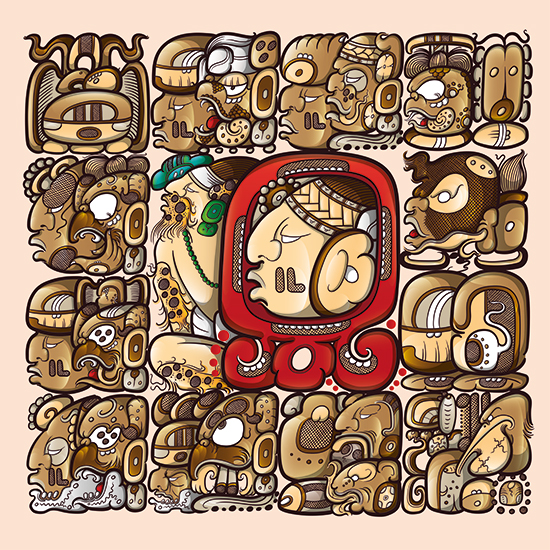Walter Paz Joj
Foundations of Knowledge
Walter Paz Joy, who is one of the most prominent voices the cultural revitalisation among the Maya in Guatemala has created two works specifically for ToRS, "Weavers of Time" and "Words from the Sky". The two works link in text the founding of the University of Copenhagen in 1479 with the inauguration of ToRS' new location on South Campus in 2013 and also draw a connection between the knowledge producers of classical Mayan culture and ToRS researchers.
Walter Paz Joj (1986 Pan Ajache’l, GT)
Walter is a Kaqchikel Maya from Pan Ajache’l (Panajachel), a little town near the Lake Atitlán, in the highlands of Guatemala. He is an ajtz'ib' (Maya scribe), graphic designer by profession, student, researcher and teacher of Maya art, music and hieroglyphic writing. His interests are the re-creation of Classic Maya hieroglyphic texts and iconography in combination with other Maya languages, cultural traditions and world view, including that of the Kaqchikel, the linguistic and ethnic group to which he belongs. Walter mainly works with digital illustration tools, publishing them on virtual platforms as a gallery open to the public and as a reference for contemporary Maya art.
Since 2012, he has also developed workshops, where he teaches the use of the Maya writing system, thus contributing to its dissemination for people interested in the topic (both Maya-speaking and non-Maya-speaking), prioritizing Maya communities in various Maya-speaking regions of Guatemala and southern Mexico.
Walter has participated in different workshops related to Maya writing, just as he has worked for various institutions, universities, artists and researchers at a national and international level. Much of his focus has been the application of new illustrative tools when it comes to writing with in the Maya script. One of the main objectives of his work is the dissemination, sharing and teaching of Maya hieroglyphic writing, with the aim of contributing to the cultural reevaluation of the current Maya with their ancestors, the ancient Maya.
Tejedores del Tiempo (Time Weavers), 2022, Guatemala
Transskription
tzi-ka-¿?-HAB’ BULUK-PIH LAJKA’-WINALHAB’ WAXAKLAJUN-HAB’ LAJKA’-WINAL-la KA’-K’IN-ni B’OLON-IK’ HO’LAJUN-MUWAN-ni tz’o-ko-sa-b’a NAH-hi-li xo-ki ‘u-ti-ya CHAN-na-CH’EN-na je-2le-K’AK’-NAB’-AJ-p’o-lo-mo[b’o]
Transliteration
“Tziik Muwaan? haab’, buluk pih, lajka’ winalhaab’, waxaklajun haab’, lajka’ winal, ka’ k’in, [ta] B’olon Ik’, [tu] Ho’lajun [te’] Muwaan, tz’o[‘o]ksa[‘a]b’ na[‘a]hil xook ‘uhtiiy chan ch’e’n Je[’e]lel K’a[h]k’ Na[h]b’ Ajp’olomo[‘o]b’”.
Translation
11.12.18.12.2 9 Ik’ 15 Muwaan (1. june, 1479)
The counting of the years of Muwaan begins:
There are 11 periods of 400 years, 12 periods of 20 years, 18 years, 12 periods of 20 days and 2 days until the day 9 Ik', on the 15th day of the 20-day period of Muwaan, the house of learning, knowledge and studies was inaugurated; it happened in the city of the Harbour of Merchants (Copenhagen).

Palabras del Cielo (Words from the Sky), 2022, Guatemala
Transskription
LAJKA’-MIH-WINAL-ji-ya KA’-HAB’-ya HUK-WINALHAB’-ya JUN-PIH-HAB’-ya ‘i-‘u-ti B’ULUK-HIX LAJKA’-mo[lo] tz’o-ko-sa-b’a ‘u-TUN-ni-b’e-ne NAH-hi-li xo-ki ‘u-ti-ya CHAN-na-CH’EN-na je-le-le K’AK’-NAB’ AJ-p’o-lo-mo[b’o]
Transliteration
“Lajka’ [k’in], mih winaljiiy, ka’ haab’iiy, huk winalhaab’iiy, jun pih haab’iiy ‘iu[h]t B’uluk Hix [tu] Lajka’ [te’] Mol, tz’o[‘o]ksa[‘a]b’ ‘utú[‘u]nb’en na[‘a]hil xook ‘uhtiiy chan ch’e’n Je[’e]lel K’a[h]k’ Na[h]b’ Ajp’olomo[‘o]b’”.
Translation
1.7.2.0.12 9 Hix 12 Mol (September 1, 2013)
12 days elapse from the previous date, (plus) a completion of a 20 day cycle, 2 years, 7 periods of 20 years, a period of four hundred years when the date 9 Hix occurs, on the 12th day of the 20-day period of Mol, when it is finished, the new house of learning, knowledge and studies; (this too) happened in the city of the Harbour of Merchants (Copenhagen).
Iconography
Above to the left is a personification of the solar deity K'inich Ajaw, with the hieroglyphic sign K’IN (sun, day) on his forehead, back, arms and legs. The solar rays are represented by the obsidian disc and the centipede shown behind the seated Sun god. His hand gesture indicates movement and that he intends to speak.
On the right you see the Moon goddess Ix Uh with her rabbit. The moon, represented in the shape of a young woman, holds a rabbit in her arms, a motif often found in Classic Maya art and sacred narratives in which the rabbit is portrayed as a mischievous and playful creature intimately associated with this female celestial body. In the center, flanked by the Sun god and Moon goddess, is an avian representation of the heaven, or Chan (CHAN-na) in Maya, adorned with large, green jade earflares. In ancient Maya writing, the sign for “sky” has a variant in the shape of a bird's head.
The lower central image shows an elderly scribe. He wears the a characteristic headdress associated with Maya scribes, and holds in one hand a brush and a screen-fold book in the other. He has just written the word for “star” - ek’ - inspired by what he observes in the night sky. In front of him is a free-flowing variant of the hieroglyphic sign IL, meaning “to see”. The old scribe is enclosed by so-called sky-bands with hieroglyphic references to the darknnes of the night, the sky itself, the stars, the sun and the moon. At his feet, can be seen his ink shell and behind him, for his comfort when he is writing, he has a large pillow covered with jaguar pelt. The old scribe thus fulfills the dual role of scribe and astronomer.

